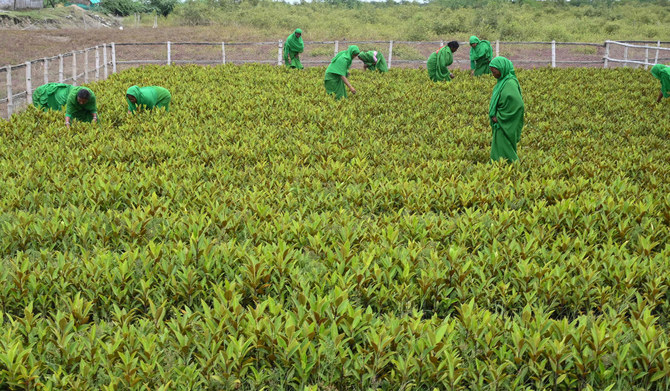Ranvir S. Nayar
These days, positive news about ecology is a rare thing, as most reports deal with catastrophes and dire warnings. Thus, it was heartening when, on July 26, which is recognized as the International Day for the Conservation of the Mangrove Ecosystem, the Food and Agricultural Organization of the UN released a report saying that the rate of destruction of mangroves around the world has decelerated, mainly thanks to localized efforts.
The FAO stated that, over the past 40 years, more than 20 percent of mangroves across 123 nations were destroyed, mainly due to human activity. In 2020, the world had only 14.8 million hectares of mangroves left. However, the UN organization encouragingly added that the rate of destruction of mangroves in the decade 2010 to 2020 fell by 23 percent compared to the previous decade. Even more encouraging was the news that almost 400,000 hectares of new mangrove forest had grown in areas where it was not present in 2000.
Further, the decrease in the destruction of mangroves was spread across the world, with Asia, home to more than 50 percent of global mangroves, seeing a significant decrease of 54 percent in its rate of destruction, while North and Central America actually saw an increase in net area of mangroves. Worryingly, however, increases in net losses were seen in Oceania and South America.
The news from the FAO is certainly encouraging, but the threat to the mangroves is far from over. Human activity is still leading to their destruction in many parts of the world, notably the coastal areas of developing nations. It is important to note that, while the rate of destruction has fallen, we are still losing mangroves at a rapid clip.
And humans are not threatening the mangroves only directly through their activities in mangrove areas. Climate change, also provoked by human activity, has emerged as a significant threat to mangroves, which are highly sensitive and fragile. Climate change threatens not just the plants, but the entire ecosystem of plants and animals harbored by mangroves.
The rising level of carbon dioxide in the air and increasing salinity and temperatures in the seas are noxious for mangroves, which also face existential threats from rising water levels and violent storm surges that are becoming increasingly common due to climate change.
Reports indicate that, in Asia alone, more than 3.5 million people are at risk due to the disappearance of mangroves. But the threat is not just in Asia. Analyst reports say that, among the countries with the highest vulnerability to tropical cyclones and the largest area of mangroves, the estimates show that sea level rise due to climate change is likely to destroy 100 percent of coastal mangroves in Mexico, 85 percent in the Philippines, 59 percent in Venezuela, 31 percent in Papua New Guinea and 27 percent in Myanmar. This shows that the risk to mangroves is not limited to a single region.
One can never overstate the importance of mangroves for the well-being and even the survival of the planet as we know it. They are not just huge reserves of biodiversity, but they also produce food for human consumption. And they trap fertile soil, sediment, nutrients and contaminants to maintain water quality and protect coral reefs, which also provide coastal protection and support fisheries and tourism.
They also act as a cushion to coastal areas, protecting them against storms and rising seawater. But perhaps the most crucial role played by the mangroves is sucking noxious carbon dioxide out of the atmosphere. Scientists say that they are among the most carbon-rich ecosystems on Earth, storing an estimated 6.23 gigatons of carbon worldwide in their biomass and soils. If we can regenerate the mangroves, then we can ensure that they can continue removing greenhouse gases at least to some extent.
In this era of carbon offsets, mangrove restoration is one of the easiest ways that the biggest polluters in the world can try to decrease the harm they do on a daily basis.
But one certainly cannot and should not wait for corporate leaders, who are only concerned about shareholder returns and their own financial packages, to take remedial action.
Restoring mangroves and even enhancing them is a relatively simple task, but one that needs commitment by the entire community living in the vicinity of the mangroves, and not even a lot of money. The fact that it can be done locally and very effectively is perhaps best highlighted by the resounding success of the restoration of mangroves undertaken by the King Abdullah University of Science and Technology in Saudi Arabia.
Thanks to a concerted effort by the university, located north of Jeddah on the Red Sea, the mangroves at and around the campus have not only been protected, but have seen a dramatic regeneration. According to the university, the area covered by mangroves has risen by 45 percent to 110 hectares.
In 2017, KAUST also set aside an additional 152 hectares as a nature conservation area as part of its commitment to protect and enhance the local biodiversity.
While these numbers may be small compared to what is needed all over the world, it is crucial to remember and acknowledge that the responsibility of protecting our planet and restoring its biodiversity is not the responsibility of one person, institution, company, community or country.
Collectively, if the leaders of every business, every community and every country follow the example set by the likes of KAUST, mangroves can indeed be saved and even grown more than ever. For they are the most effective bulwark against the damage caused by climate change.







